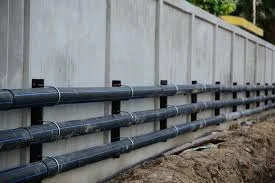Dez . 23, 2024 09:01 Back to list
hdpe welding rod
Understanding HDPE Welding Rods Importance, Applications, and Techniques
High-Density Polyethylene (HDPE) welding rods are essential tools used in the welding of HDPE thermoplastic materials. Known for their strength, durability, and resistance to moisture, UV light, and chemicals, HDPE is commonly utilized in various applications, from industrial tanks and pipes to consumer goods and structural components. This article delves into the significance of HDPE welding rods, their applications, and the techniques used in the welding process.
The Significance of HDPE Welding Rods
HDPE welding rods serve multiple purposes in the manufacturing and repair processes of HDPE products. The primary function of these rods is to facilitate the joining of two or more pieces of HDPE material through a welding process, which creates a strong, durable bond that maintains the integrity of the original material. The rods themselves are composed of the same HDPE material, ensuring that the welded joints possess similar properties to the base material, such as flexibility, chemical resistance, and longevity.
One of the significant benefits of using HDPE welding rods is their ability to create joints that are as strong as, if not stronger than, the original HDPE material. This quality is particularly important in applications where structural integrity and resistance to environmental factors are crucial. Moreover, HDPE welding rods allow for efficient repairs of plastic components without the need for complete replacement, making them a cost-effective solution for industries.
Applications of HDPE Welding Rods
The applications of HDPE welding rods are diverse, ranging from industrial to commercial and even residential projects
. Some common uses include1. Water Management Systems HDPE is widely used in pipes and fittings for water supply, drainage, and sewage systems. Welding rods help to create strong, leakage-free joints that are essential for these applications.
2. Tank Fabrication HDPE welding rods are often used to manufacture water tanks, chemical storage tanks, and other containment systems. These rods ensure that the tanks are watertight and resistant to the corrosive nature of the stored substances.
3. Geosynthetics In civil engineering, HDPE is used in applications such as liners for landfills, ponds, and reservoirs. Welding rods are crucial in joining geosynthetic materials, preventing leakage and environmental contamination.
hdpe welding rod

4. Marine Applications HDPE is also prevalent in marine environments for applications like docks and pontoons due to its resistance to saltwater and UV radiation. Welding rods enable the assembly and repair of these structures efficiently.
5. Signage and Displays In signage, HDPE is becoming a popular choice due to its durability. Welding rods help create seamless signs that can withstand the elements.
Techniques for HDPE Welding
There are several methods for welding HDPE using welding rods, including hot air welding, extrusion welding, and electrofusion
1. Hot Air Welding This technique involves using a hot air gun to heat both the base material and the welding rod simultaneously until they reach a molten state. The two surfaces are then pressed together, and as they cool, a strong joint is formed. This method is ideal for thin materials and is versatile for various welding positions.
2. Extrusion Welding In this method, a welding machine feeds the HDPE rod into a heated nozzle, melting it as it is extruded onto the joint. This technique is more suitable for larger applications and allows for a continuous weld, making it effective in manufacturing tanks and large structures.
3. Electrofusion This technique involves the use of special fittings with built-in heating elements. By connecting these fittings to a power source, the HDPE material melts, creating a strong bond once cooled. Electrofusion is commonly used for joining pipes and is especially effective for underground installations.
Conclusion
HDPE welding rods are vital for the effective joining and repair of HDPE materials across various industries. Their versatility in applications, coupled with the ability to create strong and durable welds, makes them an indispensable resource in the manufacture and maintenance of HDPE products. Understanding the various welding techniques and their specific applications is crucial for professionals in the field, ensuring that projects are completed efficiently and to the highest standards. As industries continue to evolve and adopt more sustainable materials, the importance of HDPE and its welding solutions will undoubtedly grow.
-
Durable PP Rigid Sheet: Lightweight, Chemical Resistant Solutions
NewsAug.21,2025
-
PVC Grey Sheet for Extraction: Chemical Resistant & Durable
NewsAug.19,2025
-
Durable PVC Pipe Fittings for Plumbing & Irrigation Needs
NewsAug.18,2025
-
HDPE Steel Belt Reinforced Spiral Corrugated Pipe | High Strength
NewsAug.17,2025
-
HDPE Pipe Fittings: Durable, Leak-Proof Solutions
NewsAug.16,2025
-
Premium CPVC Sheet: High-Temp & Chemical Resistant Solutions
NewsAug.15,2025

